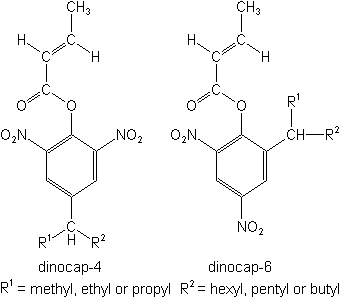-
Common NameDinocap
-
中文通用名消螨普
-
IUPAC(RS)-2,6-dinitro-4-octylphenyl crotonates and (RS)-2,4-dinitro-6-octylphenyl crotonates in which “octyl” is a mixture of 1-methylheptyl, 1-ethylhexyl and 1-propylpentyl groups
-
CAS2(or 4)-isooctyl-4,6(or 2,6)-dinitrophenyl (2E)-2-butenoate
-
CAS No.39300-45-3
-
Molecular FormulaC18H24N2O6
-
Molecular Structure
-
Category
-
ActivityAcaricide/Miticide,fungicide
-
PremixMeptyldinocap+Azoxystrobin
Dust, liquid concentrate, wettable powder. Premix Parters: glyphosate; paraquat.
-
Physical PropertiesMolecular weight:364.3. Physical form:Dark brown liquid. Density:1.10 (20 °C); Composition:Originally thought to be 2-(1-methylheptyl)-4,6-dinitrophenyl crotonate (i, n=0). Now known that the commercial material is a mixture comprising 2.0-2.5 parts of 6-octyl isomers (i) to 1.0 part of 4-octyl isomers (ii). See IUPAC definition Vapour pressure:5.3×10-6 mPa (20 °C); 7.5×10-5 mPa (25 °C); Partition coefficient(n-octanol and water):logP = 4.54; Solubility:Almost insoluble in water (<0.1 mg/l). Soluble in most organic solvents, e.g. acetone, methanol, heptane.; Stability:Rapidly decomposed by light. Decomposes >32 °C. Stable in acidic media. Hydrolysis of the ester group occurs in alkaline media. 2-(1-methylheptyl)-4,6-dinitrophenyl crotonate hydrolysed in aqueous methanol.
-
ToxicologyOral:Acute oral
LD50 for male rats 980 mg/kg, female rats 1190 mg/kg, dogs 100 mg/kg (F. S. Larson et al., Arch. Int. Pharmacodyn. Ther., 1959, 119, 31). Percutaneous:Acute percutaneous LD50 for rabbits >4700 mg tech./ kg, >2350 mg a.i./ kg (as 250 g/ -
Environmental ProfileEcotoxicology:
Bees:Not toxic to bees.Fish:Toxic to fish.
Environmental fate:
Animals:In rats, following oral administration, dinocap is almost entirely eliminated rapidly in the urine and faeces. In dairy cows, dinocap and its metabolites are excreted almost completely in the faeces, with only a small amount in the urine. The nitro groupsSoil:In soil, the principal metabolite is 2,4-dinitro-6-(2-octyl)phenol. Details are given in J. Agric. Food Chem., 1984, 32, 1151. SoilDT50 4.5-6.1 d (silt loam and fine sandy loam) by microbial degradation. Plant:Metabolism follows the same course as in animals.
WATER SOLUBILITY: Practically insoluble. -
Transport InformationSignal Word:CAUTION; Hazard Class:III (Slightly hazardous)
Porduct NewsMore
Orthosulfamuron boosts sugarcane production, study finds
Glyphosate price plummets 40% in one year in Argentina
Indian govt stops imports of herbicide Glufosinate priced below Rs 1,289 per kg
Carbendazim fungicide wins victory in Brazilian Parliament
Corteva presents new pre-emergent herbicide Linear for sugarcane in Brazil
Picloram Triclopyr Aminopyralid
Revolutionizing disease prevention: BASF launches new rice fungicide Cevya® in China
Thiamethoxam is allowed again in Brazil by a judicial decision
Bayer develops alternative to glyphosate herbicide

 0
0 Subscribe
Subscribe
